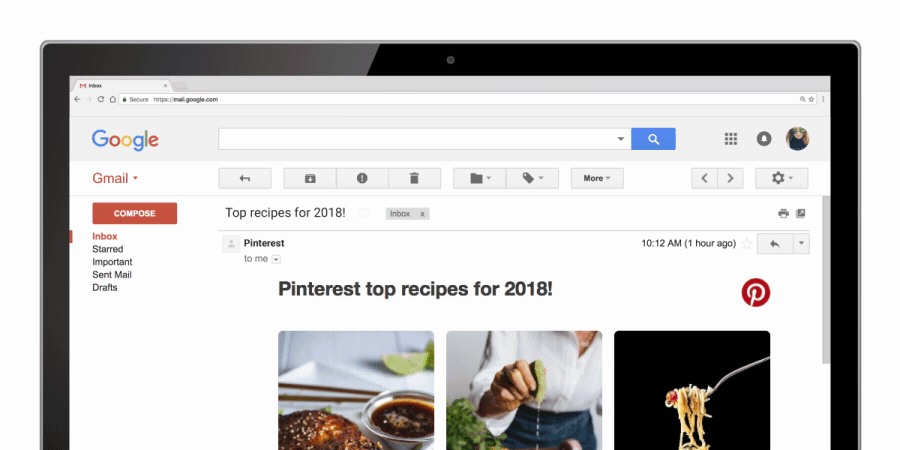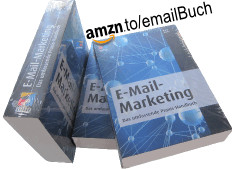A few days ago, Google announced a plan to enable “more engaging, interactive, and actionable email experiences” by bringing AMP to email. While interactive email and real-time content are supposedly big trends in the email industry, feedback from developers was modest, to say the least – for good reasons.
About AMP and the new MIME part
The AMP (Accelerated Mobile Pages) project is Google’s open-source framework designed to improve the performance of web content and advertisements. Its original goal was to make mobile pages load faster. Today, the credo is to enable “the creation of websites and ads that are consistently fast, beautiful and high-performing across devices and distribution platforms”.
Last week, the AMP project has been extended by an AMP4EMAIL proposal. The goal of the new specification is “to enhance and modernize the email experience through added support for dynamic content and interactivity while keeping users safe”.
To use AMP4EMAIL, a sender has to embed AMP HTML in the message body as a new MIME part. MIME (Multipurpose Internet Mail Extensions) is the internet standard that allows you to put different content types like plain-text and HTML as separate parts into your email. The new AMP part will be rendered by email clients supporting the spec, with graceful fallback to non-AMP content.
Here’s what an email with the new MIME part could look like:
MIME-Version: 1.0
Content-Type: multipart/alternative; boundary="----=_Part_16933578_1687195995.1518333358392"
------=_Part_16933578_1687195995.1518333358392
Content-Type: text/plain
Hello World
(. \
\ |
\ |___(\--/)
__/ ( . . )
"'._. '-.O.'
'-. \ "|\
'.,,/'.,,mrf
( \
\ \
/ / |\\
/ / .-`````-. / ^`-.
\ \ / \_/ {|} `o
\ \ / .---. \\ _ ,--'
\ \/ / \, \( `^^^
\ \/\ (\ )
\ ) \ ) \ \
jgs ) /__ \__ ) (\ \___
(___)))__))(__))(__)))
------=_Part_16933578_1687195995.1518333358392
Content-Type: text/html
<!doctype html>
<html>
<head>
<title>Hello World</title>
<meta charset="utf-8">
</head>
<body>
<p>Hello World</p>
<img src="https://loremflickr.com/400/300?random=1" width="400" height="300" alt=""/>
<img src="https://loremflickr.com/400/300?random=2" width="400" height="300" alt=""/>
</body>
</html>
------=_Part_16933578_1687195995.1518333358392
Content-Type: text/x-amp-html
<!doctype html>
<html amp4email>
<head>
<title>Hello World</title>
<meta charset="utf-8">
<style amp4email-boilerplate>body{visibility:hidden}</style>
<script async src="https://cdn.ampproject.org/v0.js"></script>
<script async custom-element="amp-carousel" src="https://cdn.ampproject.org/v0/amp-carousel-0.1.js"></script>
</head>
<body>
<p>Hello World</p>
<amp-carousel width="400" height="300" layout="responsive" type="slides">
<amp-img src="https://loremflickr.com/400/300?random=1" width="400" height="300" layout="responsive" alt=""></amp-img>
<amp-img src="https://loremflickr.com/400/300?random=2" width="400" height="300" layout="responsive" alt=""></amp-img>
</amp-carousel>
</body>
</html>
------=_Part_16933578_1687195995.1518333358392
We know that the text/plain part of the above email could render like this:

We also know that the text/html MIME type could look like this:

Now, this is new: The AMP for Email’ified text/x-amp-html part may look like this in an email client, which supports the specification…

Note the interactive arrows on the left and on the right side of the image.
How to code such an interactive AMP EMAIL?
The above example is straightforward. Let’s inspect the text-x-amp-html part of the email, or rather the AMP-HTML code inside.
To enforce email users’ expectations of security and privacy, AMP for Email proposes a strict amp4email email validation specification, as indicated by the attribute on the document element. The email itself first loads the AMP Carousel javascript from ampproject.org, which provides us with the amp-carousel component. The component then organizes both amp-img images in an interactive and responsive carousel widget. That’s about it.
Again, this is what our AMP EMAIL looks like in HTML:
<html amp4email>
<head>
<title>Hello World</title>
<meta charset="utf-8">
<style amp4email-boilerplate>body{visibility:hidden}</style>
<script async src="https://cdn.ampproject.org/v0.js"></script>
<script async custom-element="amp-carousel" src="https://cdn.ampproject.org/v0/amp-carousel-0.1.js"></script>
</head>
<body>
<p>Hello World</p>
<amp-carousel width="400" height="300" layout="responsive" type="slides">
<amp-img src="https://loremflickr.com/400/300?random=1" width="400" height="300" layout="responsive" alt=""></amp-img>
<amp-img src="https://loremflickr.com/400/300?random=2" width="400" height="300" layout="responsive" alt=""></amp-img>
</amp-carousel>
</body>
</html>
You can try it out yourself; to do so, just copy the above AMP EMAIL and paste it in on the left side at AMP Playground:

The right side then shows the rendered representation of your code. Feel free to experiment with different parameters and components.
What possibilities does AMP4EMAIL offer?
The image carousel is a simple example. AMP for Email has a lot more to offer. It does not cover the whole AMP spec due to email-specific security reasons. However, supposedly email-safe components like amp-form, amp-anim,amp-lightbox and some others open up interesting options for interactive features and real-time content, i.e. content that updates upon opening an email.
At the AMP Conf 2018, which took place on Feb 13 and 14 in Amsterdam, Doodle, Booking.com, and Pinterest explained how they use it. AMP EMAILS allow their subscribers to respond to surveys and pick availabilities, they can explore offers, update email preferences, browse through pins and save them – all right within the email, without visiting landing pages. It’s the interactive real-time content, which email marketers always dreamed of, and which was previously reserved for html experts and agile applications like Liveclicker or Multifunction Mail (in Germany).
Here is what an interactive Gmail experience with Pinterest emails looks like:

If you got 20 minutes, watch the AMP Conf 2018 video here:
Can I use AMP for Email, now?
Not really. The proposed AMP for Email specification is available on github.com/ampproject, now. Google also offers a limited number of marketers to sign up for a Gmail Developer Preview. The preview allows to start building and testing dynamic AMP EMAILS in Gmail. In order to participate, a legal contact first has to sign Google’s non-disclosure agreement.
Apart from the preview, the launch date is unclear, as well as the supported email clients. Google announced that “AMP for Email [… ] will be supported in Gmail later this year.” So it remains to be seen whether this includes, for example, Gmail for Android and Inbox by Gmail, and if “later” actually means “end of [2018]”.
Although AMP for Email is an open specification, it is unlikely that other email providers like Microsoft will adopt it. This did not happen with schema.org Email Markup, let alone with AMP, which was taken up with mixed feelings in the past.
Controversies around AMP & AMP4EMAIL
The general cheering among developers after this news is rather restrained. There are several reasons for this.
The proposed specification stipulates that another email MIME type is to be sent, along with the usual text/plain and text/html (see the initial code box). Another part, however, would require many emailing platforms and libraries to update. This did not happen with text/watch-html for Apple Watches, and my guess is that it also will not happen with text/x-amp-html. Besides that, another MIME part also means that emails get bloated even more. In the past, email weight grew especially due to mobile optimizations:

Criticism also concerns Google’s supposed strategy to further expand market dominance, and maybe using it to gain an illegal advantage again and again? A heavily discussed column on Techcrunch warns that AMP is “Google exerting its market power to extend its control over others’ content. […] People leave Gmail all the time to go to airline webpages, online shops, social media, and other places. Places that have created their own user environments, with their own analytics, their own processes that may or may not be beneficial or even visible to Google. […] But if these everyday tasks take place inside Gmail, Google exerts control over the intimate details, defining what other companies can and can’t do inside the email system — rather than using the natural limitations of email”. The market power is evident since Gmail owns probably between 20 and 30 %, and Google, of course, wants to monetize it:

Emailgeeks add that instead of extending a contentious and Google-controlled specification to the email environment, one should have better focused on further supporting existing HTML and CSS standards to allow for forms, CSS animations and interactivity, and other things in Gmail.
As an aside: I personally never believed in the pretended interactive email trend. Geeks talk enthusiastically about for about two and a half years. Image carousels and the like (see GIFs below) are indeed nice gimmicks. They which are in line with specialized html coding skills, but not necessarily with subscriber needs. Besides (mostly) only providing limited value, interactive emails might not work in important email clients anyway. (I must admit that maybe I don’t share the enthusiasm just because I’m really bad at designing emails 😉 .)






This looks quite different when it comes to real-time email content. Some critics believe that any email should always be like an immutable copy of a conversation, and AMP opposes this. It may apply to business correspondence and transactional scenarios. In newsletter communications, however, the way of thinking that emails are static after they have been sent has long since been superseded. Personalized email recommendations, calculated and rendered by AI-driven recommendation engines in real-time upon email opening, become more and more the norm. Emails change depending on the context – time, location, device, recent activities. This technology has already proven its value.
Final thoughts
All in all, my guess would be that in one year, AMP for Email adoption is not greater than the adoption of quick actions.
Feel free to form your own opinion about whether the reservations against AMP for Email are based on conspiracy theories, or whether it is really a Trojan horse. Here’s part of the discussion on Twitter:
- Good discussion on AMP for email on @litmusapp podcast https://t.co/NykPtpoWZT & @FreshInbox https://t.co/BjkhnLDBMS
- The possibilities of Google AMP for Email are pretty crazy. An email becomes a mini-application enhancing the user experience. Our Agency (BrightWave) is all over this. https://t.co/TIruHLGhoU https://t.co/yZr1146rSl
- CEO of @FastMail, @brongondwana, talks about how Gmail+AMP presents an existential crisis for email and says it threatens the immutability of email. https://t.co/4lXFCA6tLf
- I agree, the drive should be to support current #W3C standards (minus JS) not push #AMP https://t.co/CclB6Slvly
- “Google is bringing AMPs to Gmail. The company has just launched the Gmail Developer Preview of AMP for Email,… https://t.co/SsFV9LB47S
- I hate AMP websites, and bringing it to email sounds terribad. @google is going a little far and overstepping standards too much. https://t.co/DdGNmLBD7A
- Google is introducing some big changes to email. Might not do much for security, but the new AMP for Email features sound great for marketers. https://t.co/A9ECGHryof
- “Gmail will require a separate MIME-type for the AMP version of the email: text-x-amphtml.” Hmm…
- Web-like actionable content to #Gmail! AMP for Gmail will make it possible https://t.co/EnkXQQ1KrB https://t.co/OhWbabLMTW
- Yes, it will make sure no user is able to ever leave Google’s ecosystem. They started with AMP for search, so email is the next progressive step. https://t.co/oQ9dNOguyT
- AMP for Email Security adds advanced threat capabilities to protect your network before, during and after an attack. https://t.co/H7vpAgaBW8
- Just published some more personal thoughts on @AMPhtml for email: https://t.co/jKRJnNpKfR #emaildesign #emailmarketing #emailgeeks #webstandards Don’t forget to check out me and @KevinMandeville debating it on the podcast: https://t.co/VuGH1huzWN https://t.co/8wT3NyuFZS
- (1) Yesterday, Google announced AMP for email: a way for more interactive emails. I read it and didn’t think too much about it but it seemed reasonable: https://t.co/vqH61bLdC1
- Google AMP for email will allow content within email to be updated, and recipients will be able to browse email content much like they would a web page. I’m interested to see how this will compete or compliment services like @movableink and @Liveclicker https://t.co/067rdwkkXq
- @TechCrunch consesus tells us to learn enough about #AMP to not use it. What does @associationsnow say? https://t.co/6dmUJwAdc1
- Google’s big plans for email will give it even more power: Google’s about to make your inbox a much more interesting place https://t.co/4YeEv3Hg5H #Google #Uncategorized #AMP
- Really hope other email clients are going to adopt AMP for Email. Love it! https://t.co/o1gLLEys29 #AMPConf
- Early in my career when I was responsible for Email Marketing, I couldn’t count the times I was asked can you update the email content after it was sent. 15 years later the answer very soon will be yes! https://t.co/DhayR55hTs #bigdata #google
- @advenix Justin, Great in time post – I personally think, that this will highly increase email experience + engagement via @FreshInbox https://t.co/R7liaH5OGU
- With AMP for Email, it’s easy for information in email messages to be dynamic, up-to-date and actionable. #amp #email https://t.co/66zEZglYn9
- Correction: s/feeling/being/. Last straw? AMP for email. Google, a message for you: stop trying to use your monopoly to rewrite web standards, k? I don’t know what internet you think you are using but I want no part of it.
- Emails are becoming more interactive (at least in @gmail for now) with #AMP for email. https://t.co/P9cQx9dxLv #EmailMarketing
- Google Thinks The Future Of The Web Is . . . Email https://t.co/tY58hQc3nn < with AMP for Email, you never need to leave the message itself to browse web content… #socialmedia #innovation
- New post: Is Google Being Evil Again With the Launch of AMP for Email? https://t.co/vX0FiFzUix https://t.co/mNa0GbujOa
- “Email is your electronic memory” https://t.co/FcjNXGKuwL Basically, AMP for email is a bad idea.
- Will Google control Email and Content Market through AMP https://t.co/IlnJ3LpMdu
- This guy clearly has doesn’t like Google! I think Amp for email is a pretty neat idea. Why wouldn’t we want our industry to deliver something more creative? I am interested in the use cases and the results when brands start using it. https://t.co/uMkr8lKoUm
- AMP for email is a terrible idea. Monopolies only benefit the monopoly holders. And won’t help you. Via @TechCrunch https://t.co/CxUXqITigb
- In reality, there is a huge elephant in the room that people seem to be overlooking. In order for google’s #AMP emails to work, the receiver needs to be on a #Gmail client. https://t.co/CUEvpV4LST
- AMP in Gmail has the potential to dramatically increase click-throughs and conversions on e-commerce at the expense of being open But if being open wasn’t providing any meaningful benefit to the consumer for years then… https://t.co/n6AP5YGZFt
- Good thoughts why AMP for email and AMP are shit. Basically another way for Google to dominate the Ad market even more. Time to cut Google put where you can. https://t.co/6aWQvIcoaW
- Finally. Google is developing AMP for email. About damn time, really. https://t.co/FVJpBfyvTk
- #AMP for email? “dynamic and up-to-date”? SHIT NO! That’s not what email is. Email is immutable! My copy of the conversation. And: No company owns it. https://t.co/MUvRvnQu3L https://t.co/sPVOSgrcnp
- Not sure i agree, but it’s a good read. There is plenty of live content available in email via @movableink @PowerInbox @Liveclicker already so the idea is not new, rather this is google entering that space. “AMP for email is a terrible idea” | TechCrunch https://t.co/cw4Hpw2Vqd
- I’m not talking about email, just about how AMP is the worst idea ever. It promotes vendor lock-in, increased complexity, unnecessary overload for developers and so on. I hope to spit on its grave. https://t.co/rh3yIVvuTK
- It would be nice to see what the #AMP email fallback code would look like. Since even images require a custom tag and JS to render. https://t.co/5fYme1DuWH
- AMP for email sounds even worse than AMP. https://t.co/ZODy8dHE9Q
- “No company owns it. It works reliably and as intended on every platform, every operating system, every device. That’s a rarity today and a hell of a valuable one.” from “AMP for email is a terrible idea” https://t.co/to4rmof1Rm https://t.co/foCibqtHkn
- I’ve never wanted anything on the web more than interactive emails. AMP for Email is exactly what the world deserves. Thanks Google! /s https://t.co/73jJzszJwd
- #Google just announced a plan to “modernize” #email with its Accelerated Mobile Pages (AMP) platform …which is all about enforcing a ‘silo’ for your #communications and stuffing ‘interactive’ #ads in your inbox. How to f* up #security & #privacy. Say no! https://t.co/WaSFbJSsSt
- @viticci you so anti amp you can’t see the benefits. example one thing i get is email updates on homes for sale. It’s s static page that only tells me the price and if it’s still for sale at the time the email was created. With this when you open it the info on the house can be real time.
- I can’t wait to hear people complain about how bad AMP for email is.
- AMP for gmail “Email marketers looking to leverage AMP to add interactivity to their emails will have to create a unique email entirely for Gmail.” Using MIME text-x-amphtml. > AMP […] now one of the best ways to build rich webpages > Product Manager, Gmail O’RLY?
- Other email clients may adopt AMP for Email as well? https://t.co/7zMfReR7xi
- Google rolling out AMP for email is exactly an example of Google not being receptive of feedback.
- I completely agree with this article. AMP was already a somewhat good idea but with a proprietary implementation that is slowly becoming a blight on the web. Now this is even more ridiculous. https://t.co/zCY6Ie5GMg
- For conversion-driven marketers, Google’s latest AMP email announcements have the potential to be a game changer…. https://t.co/rgSBePujMZ
- “With AMP for Email, you’ll be able to quickly take actions like submit an RSVP to an event, schedule an appointment, or fill out a questionnaire right from the email message.” https://t.co/fxYDVtD142
- The functionality #AMP4Email brings is much needed and deserved for email. But is AMP, a standard owned and developed by a single company (for a single mail client – Gmail), the best way forward? This will only widen the (already gaping) support gap in email.


